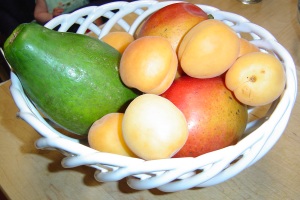
I’ve learned a lot about cooking and food this year; however, this newly acquired knowledge has not necessarily made me happier. I’m not the first person to observe the fact that knowledge is a double-edged sword: some forms of knowledge hearten, others disturb. Often, a new idea raises as many questions as it answers. That’s certainly been the case for me this year.
So, here’s what I’ve learned:
- The industrial food chain has altered the American diet in myriad consequential ways.
- All manner of grains are good, but many of the grains that are good are not available in my grocery store.
- There is something deeply satisfying about eating good, well-prepared food, something that transcends the momentary pleasures prompted by the consumption of fast, cheap foods.
- Americans are no longer seasonal eaters; in fact, as a culture, we have lost the knowledge of what types of produce are in season.
- There is a burgeoning awareness of and appreciation for alternative food sources like food co-ops, Community Supported Agriculture, farmers’ markets, and local food markets.
- This awareness of and appreciation for alternative food sources is, however, often a function of socioeconomic status. That is, appreciation seems to be commensurate to income and education.
- Organic food is not necessarily environmentally or nutritionally better.
- Eating local is best, but it demands a personal culinary revolution that I am not entirely enthusiastic about making.
- Chestnuts are delicious but demanding.
And here are some questions:
- What, exactly, is “American food?” I wrestled with this issue when I considered the subtitle of this blog (Reflections on American Cooking and Culture). Since then, I’ve gone back several times and deleted it and revised it, but I keep going back to it. Why the vacillation? Well, is what I do “American” cooking? Not always; never exactly. But as an American, what else could I be cooking? A recent book by the chef Marcus Samuelsson, The New American Table highlights the point. Samuelsson — born in Ethiopia, raised in Sweden, and now an American citizen, whose last book was on African cuisine– features recipes like tempura crab salad with tamarind-soy vinaigrette and beef curry with avocado and plantains. Are these American meals? A review of the cookbook at eatmedaily raises these questions and offers one intriguing, overarching query: “If Everything’s American, Does American Matter?’ For that matter, “If Everything’s ____, does ______ matter?” (Fill in nationality)
- Which, of course, leads to this question: do national/cultural culinary distinctions matter in an increasingly globalized world? Should they?
- Do we truly lack a stable food culture as writers like Michael Pollan argue? After reading the Little House on the Prairie books by Laura Ingalls Wilder to my three-year-old daughter, I’m not so sure. The first and second books nicely describe a fairly healthy food culture: lots of meat in the Winter, lots of vegetables in the Summer, dried grains all year-long.
- Until, of course, those grains run out, as they do in the sixth book in that series, The Long Winter, leading to a very lean and difficult time for the Ingalls family. This raises a question: are periods of scarcity a natural part of the human diet? Should we fast sometimes to regulate the body? To drop excess weight? Is this healthy? Is this reasonable in our modern lives?
- Regardless of whether or not Americans have ever had a stable food culture, we have certainly forgotten all about it now. But what can we/should we do about this?
- Circling back to an earlier issue, what is the relationship between the immigrant food culture that Samuelsson features in his cookbook and an otherwise absent American food culture?
- Is the burgeoning interest in and appreciation for alternative food sources a fad?
- To what extent will the economic downturn impact alternative food sources? We’ve already heard about the difficult times faced by organic dairy farmers. What other organic victims will there be before the economy measurably improves?
- Related: given the fact that processed and fast food is cheap and widely available while fresh, organic food is expensive and more of a challenge to get (it’s much easier to stop in at Walmart and get everything than it is to make several stops at specialty stores), how is it possible for all Americans to eat healthy whole foods?
- How I can make my kitchen as socially, environmentally responsible as I can without sacrificing too much pleasure and enjoyment? Can I still drink French wine, eat Greek olives, and order farro on-line without feeling like a boorish, carbon-hungry hypocrite?
- Is true seasonal eating compatible with a modern (busy) lifestyle?
- How can I eat seasonally without culinary over thinking?
 You see? Many more questions than answers.
You see? Many more questions than answers.
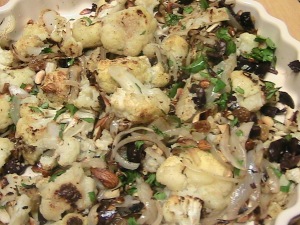
This has been a busy week filled with birthdays, guests, illness, and car trouble. We’ve managed to eat well though by relying upon a battery of easy meals made from pantry staples.
Here’s one of my favorites: Cauliflower with Almonds, Olives, and Caramelized Onions served over Cous Cous, which I’ve adapted from a recipe by Deb at Smitten Kitchen. I’ll give my version of the recipe later on, but for the moment, I’d like to ponder the nature of adaptation.
I use recipes in a variety of ways. There are some –not very many though — that I follow to the letter. These are mostly for baked goods, where precision matters. Other recipes — that is to say most of them — I use as guides more than anything else. Still others function as inspiration for radically different uses of technique or ingredients.
I suppose all cooks work this way. My question is: when does a recipe become my own? When can I claim a recipe as my own original intellectual property? I guess it’s the same question that my students have in mind when they ask me if they should cite something like the date that Columbus sailed the “ocean blue.” (It’s the same issue at work in the Charlie Kaufman film Adaptation, except without the unexpected crocodile.)
So, what is an original recipe? Are there any — well, are there any that aren’t products of molecular gastronomy? Is there anything new under the sun or deep in the ocean blue?
The cauliflower recipe — which Deb adapted from a recipe by Michael Anthony of the Gramercy Tavern, and is, therefore, an adaptation of an adaptation — is the easiest thing in the world to make and awfully tasty at the end of a long weekday, when you feel like you’ve been drowning in the ocean. And even though my own version is quite a bit different from Deb’s, I’m not prepared to call this one original property.
Cauliflower with Almonds, Olives, and Caramelized Onions (adapted from a recipe by Deb at Smitten Kitchen)
2 large onions, cut in half and thinly sliced
3 tbs. olive oil
1 large head of cauliflower, or two small heads, cut or broken into large segments
1 tsp. ground cumin
2 tbs. Sultanas (golden raisins)
1 tbs. cider vinegar
1 tbs. water
2 tbs. pitted, sliced Kalamata olives
2 tbs. toasted almonds, chopped
1 large handful of cilantro, chopped
1 1/2 cups prepared cous cous
1 Tbs. Argan oil* (optional)
1/4 tsp. Baharat **(optional)
Salt to taste
Preheat oven to 425 degrees (F). To caramelize the onions: in a large frying pan, heat 1 tbs. of the olive oil until shimmering. Add the onions and cook over medium heat for about 20 minutes, stirring occasionally, until onions are golden brown. Meanwhile, toss the cauliflower in the remaining olive oil and cumin. Scatter cauliflower onto a large rimmed cookie sheet, making sure that the cauliflower remains in one layer. Roast for 25 minutes or until the cauliflower turns golden brown.
In a small saucepan, combine the vinegar, raisins, and water. Bring to a simmer over medium high heat and cook for 2 minutes.
Cook cous cous according to the package directions.
When the cauliflower is brown and caramelized, transfer to a large, deep serving dish. Add half of the caramelized onions, toasted almonds, raisins with liquid, and olives. Toss carefully until all is combined. Scatter the remaining carmelized onions on top, along with the cilantro.
Pour the argan oil and baharat over the cous cous and gently combine with a fork. Serve cauliflower on or beside a mound of cous cous. Serves 2 adults and one three year old with a passion for olives.
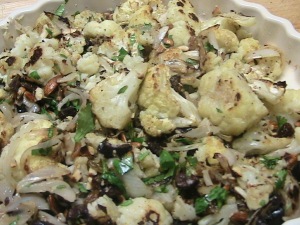
* Argan oil is the oil of the argan tree, which grows only in Morocco. Said to have miraculous healing properties, the oil is delicious on cous cous and in Greek yogurt. It tastes a bit like almond or hazelnut oil, both of which make adequate substitutes. I get organic argan oil from Zamouri Spices.
**Baharat is a very hot spice blend that is the traditional spice for cous cous. Use with caution. It’s available at http://www.thespicehouse.com.
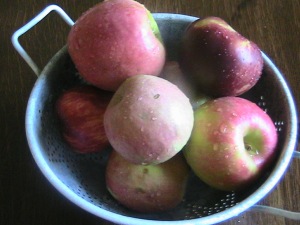
Wabi Sabi is a Japanese aesthetic ideal that is concerned with honoring simple, unadorned, natural objects and events in life, those things that are beautiful and beloved because of their imperfection and simplicity, not in spite of them. Mimi has a lovely storybook called Wabi Sabi, written by Mark Reibstein and illustrated by Ed Young, about a cat by that name who seeks to learn the meaning of its namesake. Everyone she asks begins by saying, “That’s hard to explain …”
Wabi Sabi is hard to explain, but I think that a good way of understanding it might be to consider the apple.
Surely, the apple is one of nature’s most exquisite achievements, yet humans have done their damnedest to ruin it. As proof, I offer the Red Delicious apple. How perfect it is~

But isn’t it a little odd looking, for all its genetically-engineered perfection?
I cannot love it.
I can, however, love this misshapen Arkansas Black. Lopsided, blemished, and bruised — this is a beautiful apple.
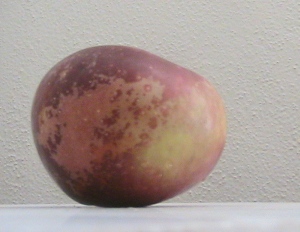
And, unlike the Red Delicious, this one tastes good. Like an apple, if you can imagine.
Mimi and I spent the morning marvelling at the imperfect beauty of pumpkins, quinces, satsumas, persimmons, and apples at the Market at Blooming Colors, a new fruit and vegetable stand in Auburn that carries mostly locally grown food. The apples, for instance, come from a farm in North Georgia and they’re pesticide free. The market is a valuable addition to the area.
The weather is cool (finally) and the market was the perfect place to spend a sunny Fall morning. We indulged ourselves in utterly simple ways: picking out pumpkins and snacking on apples and roasted peanuts. We brought home with us five flawed pumpkins and two bags full of misshapen apples: our beautiful treasures.

Lunch, eaten amid the new pumpkins on our very simple front porch, consisted of apples and cheddar cheese. What else did we need? The sky was blue, the air was cool, and we were happy.

Simply Beautiful








